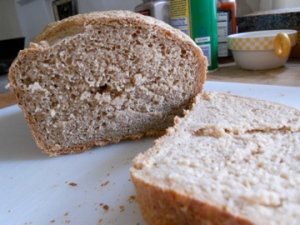My poor starter, Stanley, had been sitting in the refrigerator neglected for quite some time. About a week ago I reactivated him only to bake a loaf which I left in the oven for to long. Said loaf resembled a rock or brick the next morning when I tried slicing it for breakfast.
Fast forward to now.
I baked this loaf in a loaf pan, which I generally don’t do. I usually just freely shape in and bake it on a cookie sheet. I kind of like the pan because coating the pan with a thin sheen of olive oil gives the bread a browner and more chewy crust. The dough also retains its shape if its more on the wet side, but I like the artistic aspect of freeform loaves better. Its a compromise I suppose.
Anyways, I bake my bread with 100% white whole wheat flour. (this is NOT refined white flour, but whole wheat flour made from white wheat). I don’t keep bread flour on hand (even though it does make a better loaf) because it takes up space and I am hesitant to buy an entire bag and there is no whole wheat variety. I did however want to increase the gluten content of the bread. Enter Vital Wheat Gluten! I had an epiphany while I was meandering through the bulk section of the grocery store to try “making” my own bread flour by adding VWG to increase protein content in the regular flour. So I got a small amount (cheaper and less bulky than an entire bag) and if it failed, well, it was only a few dollars.
The ratio is 1T of VWG to 1C of flour to make “bread flour”. So, in my recipe I use 1 and 3/4C flour added to the starter. Therefore I used 1T and then a little more VWG. Looking back, I probably could have used more because I forgot that my starter contains flour too. I could tell when I was kneading that the VWG was doing something because the dough had more stringy strands form faster then usual. However, upon baking I am not quite sure if it made a huge difference. I think next time I will add 2T and then a little more and see if it is more noticeable.
In sum, VWG, I think, was a successful experiment which needs to be tampered with a little bit more.




















